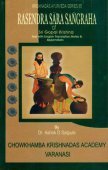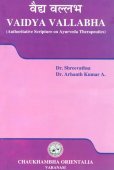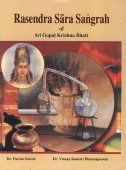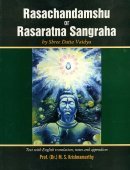Upadamsha, Upadaṃśa: 16 definitions
Introduction:
Upadamsha means something in Hinduism, Sanskrit, Marathi, Hindi. If you want to know the exact meaning, history, etymology or English translation of this term then check out the descriptions on this page. Add your comment or reference to a book if you want to contribute to this summary article.
The Sanskrit term Upadaṃśa can be transliterated into English as Upadamsa or Upadamsha, using the IAST transliteration scheme (?).
Alternative spellings of this word include Updansh.
In Hinduism
Ayurveda (science of life)
Nighantu (Synonyms and Characteristics of Drugs and technical terms)
Source: WorldCat: Rāj nighaṇṭuUpadaṃśa (उपदंश) is another name for Samaṣṭhilā, an unidentified medicinal plant, according to verse 4.23-25 of the 13th-century Raj Nighantu or Rājanighaṇṭu. The fourth chapter (śatāhvādi-varga) of this book enumerates eighty varieties of small plants (pṛthu-kṣupa). Together with the names Upadaṃśa and Samaṣṭhilā, there are a total of seven Sanskrit synonyms identified for this plant.
Dietetics and Culinary Art (such as household cooking)
Source: Shodhganga: Dietetics and culinary art in ancient and medieval India1) Upadaṃśa (उपदंश) refers to a type of dish prepared by edible roots, according to the Aṣṭādhyāyi III.4.47, and is commonly found in literature dealing with the topics of dietetics and culinary art, also known as Pākaśāstra or Pākakalā.—The roots (mūla) and fruits (phala) seems to be a common food in śrautasūtra literature. Pāṇini uses the terms bhāji and śrāṇa as the synonyms for cooked vegetables. He mentions the term upadaṃśa which stands for a dish which is prepared by edible roots such as radish and ginger. Āpastamaba states that garlic and onions should be avoided by noble persons.
2) Upadaṃśa (उपदंश) refers to “pickles” according to the 17th century Bhojanakutūhala (dravyaguṇāguṇa-kathana).—Upadaṃśa is a section which describes only the properties of pickles. Their preparation is not described here. The pickles prepared by different items like bālāmra (unripe mango), kṣudrāgrāmra (unripe baby mango), dhātrī (gooseberry), nāraṅga (lemon), jambīra (citron), etc. are described in detail.
Toxicology (Study and Treatment of poison)
Source: Shodhganga: Kasyapa Samhita—Text on Visha ChikitsaUpadaṃśa (उपदंश) or “pickle” is the name of an ingredient used in the treatment of Rājilā-snake-bites, according to the Kāśyapa Saṃhitā: an ancient Sanskrit text from the Pāñcarātra tradition dealing with both Tantra and Viṣacikitsā—an important topic from Āyurveda which deals with the study of Toxicology (Viṣavidyā or Sarpavidyā).—The tenth Adhyāya prescribes antidotes for Rājilā snake venom.—According to the Kāśyapasaṃhitā verse X.33b-38a: “A diet of rice must be cooked with Priyaṅgu and Kodrava (millet) must be given to the bitten person. Green gram, mustard seeds, pepper, large quantity of dry ginger, Asafoetida, garlic, salt and Trikaṭu are prescribed as diet and drinks along with pickle (upadaṃśa). [...]”.
Unclassified Ayurveda definitions
Source: Research Gate: Internal applications of Vatsanabha (Aconitum ferox wall)Upadaṃśa (उपदंश) refers to “syphilis” (a sexually transmitted bacterial infection). Vatsanābha (Aconitum ferox), although categorized as sthāvara-viṣa (vegetable poisons), has been extensively used in ayurvedic pharmacopoeia.

Āyurveda (आयुर्वेद, ayurveda) is a branch of Indian science dealing with medicine, herbalism, taxology, anatomy, surgery, alchemy and related topics. Traditional practice of Āyurveda in ancient India dates back to at least the first millenium BC. Literature is commonly written in Sanskrit using various poetic metres.
Shaivism (Shaiva philosophy)
Source: Brill: Śaivism and the Tantric TraditionsUpadaṃśā (उपदंशा) refers to “(various) appetizers”, according to the Mattavilāsaprahasana.—Accordingly, as the Kāpālika cries out: “My darling, look. This pub resembles the Vedic sacrificial ground. For its signpost resembles the sacrificial pillar; in this case alcohol is the Soma, drunkards are the sacrificial priests, the wine glasses are the special cups for drinking Soma, the roasted meat and other appetizers (prabhṛti—śūlyamāṃsaprabhṛtaya upadaṃśā) are the fire oblations (havirviśeṣa), the drunken babblings are the sacrificial formulae, the songs are the Sāman-hymns, the pitchers are the sacrificial ladles, thirst is the fire and the owner of the pub is the patron of the sacrifice”

Shaiva (शैव, śaiva) or Shaivism (śaivism) represents a tradition of Hinduism worshiping Shiva as the supreme being. Closely related to Shaktism, Shaiva literature includes a range of scriptures, including Tantras, while the root of this tradition may be traced back to the ancient Vedas.
Languages of India and abroad
Marathi-English dictionary
Source: DDSA: The Molesworth Marathi and English Dictionaryupadaṃśa (उपदंश).—m (S) Lues Venerea, syphilis.
Source: DDSA: The Aryabhusan school dictionary, Marathi-Englishupadaṃśa (उपदंश).—m Lues Venerea, syphilis.
Marathi is an Indo-European language having over 70 million native speakers people in (predominantly) Maharashtra India. Marathi, like many other Indo-Aryan languages, evolved from early forms of Prakrit, which itself is a subset of Sanskrit, one of the most ancient languages of the world.
Sanskrit dictionary
Source: DDSA: The practical Sanskrit-English dictionaryUpadaṃśa (उपदंश).—
1) Anything which excites thirst or appetite, a relish, condiment &c.; मूलकेनोपदंशं भुङ्क्ते (mūlakenopadaṃśaṃ bhuṅkte) Mahābhārata on P. IV.1.48; cf. P.III.4.47. द्वित्रानुपदंशानुपपाद्य (dvitrānupadaṃśānupapādya) Daśakumāracarita 133; अग्रमांसोपदंशं पिव नवशोणितासवम् (agramāṃsopadaṃśaṃ piva navaśoṇitāsavam) Ve.3.
2) Biting, stinging.
3) The venereal disease, chancre.
4) (a) A tree the root of which is used for horse-radish (śigru). (b) Name of another plant (samaṣṭhila).
-nam Context; छागोपकरण- मस्योपदंशितं यदुपदंशने पशुशब्दच्छागाभिप्राय इति गम्यते (chāgopakaraṇa- masyopadaṃśitaṃ yadupadaṃśane paśuśabdacchāgābhiprāya iti gamyate) | ŚB. on MS.6.8.35.
Derivable forms: upadaṃśaḥ (उपदंशः).
Source: Cologne Digital Sanskrit Dictionaries: Shabda-Sagara Sanskrit-English DictionaryUpadaṃśa (उपदंश).—m.
(-śaḥ) 1. A relish, or something to promote drinking. 2. The venereal disease, chancre. 3. Biting, stinging. 4. A tree, the scraped root of which is used for horse-radish, (Morunga hyperanthera.) E. upa much, &c. daṃśa biting.
Source: Cologne Digital Sanskrit Dictionaries: Monier-Williams Sanskrit-English Dictionary1) Upadaṃśa (उपदंश):—[=upa-daṃśa] [from upa-daṃś] m. anything eaten in addition (to excite thirst or appetite), a relish, spice, [Rāmāyaṇa; Kathāsaritsāgara; Suśruta; Daśakumāra-carita]
2) [v.s. ...] a kind of venereal disease, [Suśruta]
3) [v.s. ...] the tree Moringa Hyperanthera (the scraped root of which is used for horse-radish), [cf. Lexicographers, esp. such as amarasiṃha, halāyudha, hemacandra, etc.]
4) [v.s. ...] a kind of shrub, [cf. Lexicographers, esp. such as amarasiṃha, halāyudha, hemacandra, etc.]
Source: Cologne Digital Sanskrit Dictionaries: Yates Sanskrit-English DictionaryUpadaṃśa (उपदंश):—[upa-daṃśa] (śaḥ) 1. m. A relish; venereal disease; biting; Morunga tree.
Source: DDSA: Paia-sadda-mahannavo; a comprehensive Prakrit Hindi dictionary (S)Upadaṃśa (उपदंश) in the Sanskrit language is related to the Prakrit word: Uvadaṃsa.
[Sanskrit to German]
Sanskrit, also spelled संस्कृतम् (saṃskṛtam), is an ancient language of India commonly seen as the grandmother of the Indo-European language family (even English!). Closely allied with Prakrit and Pali, Sanskrit is more exhaustive in both grammar and terms and has the most extensive collection of literature in the world, greatly surpassing its sister-languages Greek and Latin.
Hindi dictionary
Source: DDSA: A practical Hindi-English dictionaryUpadaṃśa (उपदंश) [Also spelled updansh]:—(nm) syphilis.
...
Kannada-English dictionary
Source: Alar: Kannada-English corpusUpadaṃśa (ಉಪದಂಶ):—
1) [noun] that which excites thirst or appetite; a small portion of a tasty food or drink that excites a desire for more food; an appetizer as a relish, condiment etc.
2) [noun] an infectious venereal disease caused by a spirochete (Treponema pallidum) and usually transmitted by sexual intercourse or acquired congenitally; syphilis.
Kannada is a Dravidian language (as opposed to the Indo-European language family) mainly spoken in the southwestern region of India.
See also (Relevant definitions)
Starts with: Upadamshadhikara, Upadamshaka, Upadamsham.
Ends with: Supadamsha.
Full-text: Upadamsham, Upatamicam, Upadansh, Updansh, Uvadamsa, Upadamshin, Dhatri, Balamra, Kshudragramra, Navavidha, Jambira, Naranga, Samashthila, Shrana, Bhaji, Mula, Damsh, Phala.
Relevant text
Search found 3 books and stories containing Upadamsha, Upadaṃśa, Upadamsa, Upa-damsha, Upa-daṃśa, Upa-damsa, Upadamśa; (plurals include: Upadamshas, Upadaṃśas, Upadamsas, damshas, daṃśas, damsas, Upadamśas). You can also click to the full overview containing English textual excerpts. Below are direct links for the most relevant articles:
Sushruta Samhita, volume 4: Cikitsasthana (by Kaviraj Kunja Lal Bhishagratna)
Chapter XIX - The medical treatment of hernia
Chapter XXXV - Description of a Netra and a Vasti (pipes, nozzles and apparatus)
Atharvaveda and Charaka Samhita (by Laxmi Maji)
Treatment of Upadaṃśa (syphilis) < [Chapter 3 - Diseases and Remedial measures (described in Atharvaveda)]
Mādhavanidāna (Āyurveda book) < [Chapter 1 - Introduction]
Rasendrasāra Saṅgraha (Āyurveda book) < [Chapter 1 - Introduction]
Charaka Samhita and Sushruta Samhita (by Nayana Sharma)
Gender in the Saṃhitās < [Chapter 5]
Related products





